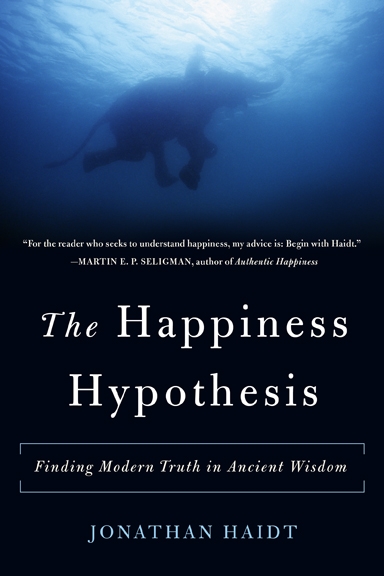 The Happiness Hypothesis by Jonathan Haidt is a book about something almost anyone with a religious background and a growing interest in science and psychology has probably wondered about. If you read almost any ancient religious text, you’ll find an awful lot of overlap between their prescriptions for happiness and what you might hear from the receiving end of a therapy session. Many years ago, I’d have rejoiced at how modern science was ‘confirming’ my religious beliefs. Today, I’m simply in awe at how all these different cultures landed so close to the mark, way before research was even really a thing.
The Happiness Hypothesis by Jonathan Haidt is a book about something almost anyone with a religious background and a growing interest in science and psychology has probably wondered about. If you read almost any ancient religious text, you’ll find an awful lot of overlap between their prescriptions for happiness and what you might hear from the receiving end of a therapy session. Many years ago, I’d have rejoiced at how modern science was ‘confirming’ my religious beliefs. Today, I’m simply in awe at how all these different cultures landed so close to the mark, way before research was even really a thing.
The Happiness Hypothesis is not an attempt to validate any religious belief. It’s also not trying to invalidate it. It’s not structured to explore the depth of any one religious tradition. Instead, it’s looking at the colloquial wisdom coming from the major world religions, as seen through the lens of positive psychology (A field of study that doesn’t just seek to understand its subjects, but to make them happy–an exceptional oversimplification).
Haidt starts his work by discussing the various ways throughout history that human beings have divided up the individual, such as between the mind (or soul) and body, or the left brain and right brain. The most important one to this book, however, is the controlled brain and the automatic brain. If you notice, a heck of a lot of religious teaching is aimed at helping people control themselves. Which, if you think about it, is pretty weird. Are we in control or not? If you look at the patterns in your life, it’s pretty clear that answer is no–or at least very complicated.
Haidt uses a metaphor of a rider on the back of an elephant. In the metaphor, the rider is the controlled (or conscious) brain, while the elephant is the automatic (or unconscious) brain. The metaphor illustrates how we can continually repeat the same unhelpful behavior, or fail to do or be the thing we declare we want; how we can make the same mistakes in money or in relationships, or in whatever, over and over and over again, all the while seemingly watching ourselves do it in slow motion and wondering “how is this happening again?” or “why am I doing this?” Like the rider on the back of an elephant, the best he can do is persuade the elephant to do what he wants, he can’t make it do anything by force.
Taming the elephant, Haidt says, is the key to happiness. It’s a complicated key though, so don’t get too excited or write it off just yet.
Our elephant is our upbringing. It’s our expectations of people and ourselves. It’s our automatic responses to fear, happiness, anger and arousal. It is the majority of the reason we do whatever it is we do at any given moment. For a lot of people, the rider is simply an observer in an unfortunate and precarious position atop the back of an out of control beast. “Oh shit, what have we gotten into here…”
The bible agrees, cryptically.
“For we know that the law is spiritual, but I am of the flesh, sold under sin. For I do not understand my own actions. For I do not do what I want, but I do the very thing I hate.” – Romans 7:14-15
For myself, and many of my former Christian brothers and sisters, this conundrum of watching as the unconscious mind brings rise to actions that befuddle our conscious mind, led to self abasement. Like the rider on the back of an untrained (or, more like unhelpfully trained) elephant beating himself for how the elephant trampled the rose bushes. In fact, that rider spends all of his time beating himself, instead of spending time developing and nurturing a partnership with the elephant.
In chapter 2, Haidt, lays out three ways people can tame the elephant: meditation, cognitive therapy and medication. Depressing. Unfortunately, for a lot of people, the elephant runs away from those options before the rider can get a word in. Progress is slow, however, and the elephant gets more comfortable with familiarity.
So in chapter 3, Haidt dives into the golden rule, discussing how reciprocity works in this grand emotional scheme of things. A lot of our lives, and what concerns our elephant, deals with our connections to other people. Our fears of abandonment, or our opportunities to exploit. When our rider gains some understanding of what’s really happening in our reciprocal relationships, we get a better handle on our automatic responses.
In Chapter 4, we look at our social structure more closely and asks why it’s so easy to see other people’s faults and completely miss our own. “Why do you see the speck in your neighbor’s eye, but do not notice the log in your own eye?”. If we can remove our “moral glasses” and see the world as it really is, we can appreciate our elephant’s self-serving inclinations, without our rider mistaking other people’s elephant for “pure evil”.
In Chapter 5, Haidt questions the common wisdom that happiness always comes from inside (hint, it mostly does), but acknowledges some of the ways our external circumstances really do matter. Chapter 6 challenges eastern philosophy which eschews love and attachment by dissecting the different kinds of love, finding that it leads to misunderstandings of that worldview, and our own.
Chapters 7 and 8 deal with adversity and virtue. Does what “doesn’t kill us” really “make us stronger”? It depends when it happens and what else is going on in your life–PTSD is a very real thing, but under the right conditions, adversity is a powerful tool to train the elephant. Do our role models and conventional wisdom help our elephant keep calm and follow our orders?
Chapter 10 makes the distinction between the purpose of life and the purpose in life, and concludes that religion has served to create a coherence in this dichotomy. One that is scarcely achieved on one’s own. The final chapter makes an appeal that the religiously minded and the scientifically minded should listen to one another. Actually, that all ideologies recognize themselves and listen to each other. And ultimately, that everyone become aware that they are both their rider and their elephant, and everyone else is too.
In Conclusion
I finished reading this book almost two books ago. Revisiting it now to do a short write up revealed that the most impactful part of the book was the picture of the elephant and the rider. It’s a useful visualization for the struggle between my unconscious and conscious mind and my pursuit of goals and satisfaction in my life. Many of the comparisons between religious principles and positive psychology weren’t anything new to me. I often found myself wondering about them as I studied scripture in years gone by, and I connected quite a few dots on my own while reading other material. It was nice to see them organized and to validate the questions I’d stopped asking. It’s a good book, worth a read.

Recent Discussion